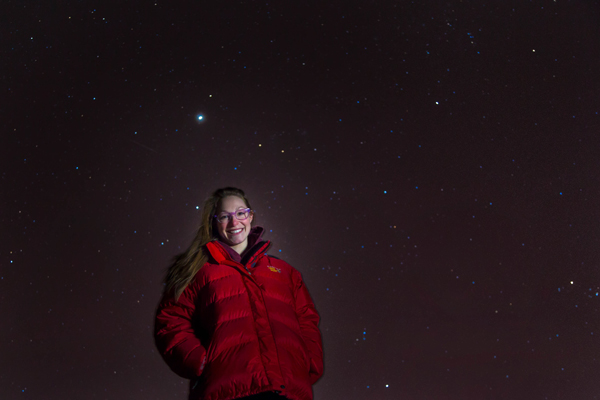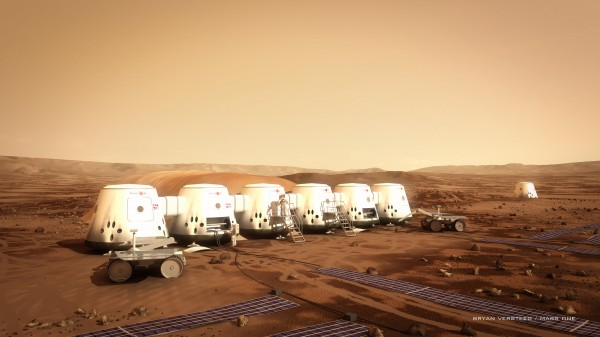UAF student may earn spot on Mars trip
March 4, 2014

Meghan Murphy
907-474-7541
3/5/14
They say reach for the stars, but 21-year-old Jessica Eicher is reaching for a terrestrial orb closer to home – Mars. In fact, the chances that the University of Alaska Fairbanks senior will go to the Red Planet just got better.
The nonprofit organization Mars One received 200,000 applications, including Eicher’s, for its proposed one-way trip to Mars. After narrowing the applications to 1,058, the organization sent Eicher an email to say she was still in the running. They also sent her fiancé, Anchorage firefighter David Barbeau, an email that read the opposite.
“More than being disappointed, I was excited that Jess had made it into the top 1,000,” he said.
The two had hoped to pioneer a life together as the first Martian family. Although their wedding is still on for this October, plans beyond 10 years might be a little hazy. The first four Earthlings are scheduled to land on Mars in 2024. Yet technology and funding must first converge on Earth before humans can dig their space boots into Martian soils.
The vision
Mars has half the girth of Earth and twice the year length. Two moons orbit the planet, overlooking a canyon that stretches the distance of California to New York. Red dust floats in the air and covers the ground, seemingly innocuous until the wind stirs it into a planet-engulfing storm.
It is there that Dutch entrepreneur and mechanical engineer Bas Lansdorp wants to start a colony. The CEO and co-founder of Mars One told reporters that the idea stemmed from his own desire to travel to Mars, although he has grounded those aspirations for now.
In his vision, four people will land on Mars every two years to establish a colony and perhaps a nation.
Colonists will have shelter, communication systems and the technology to extract water from icy Martian soils and oxygen from that water. Thin-film solar panels will generate electricity, and there will be nurseries to grow food.
Ten years of training will require candidates to live on Earth as they will live on Mars — at least for several months at a time.
The whole world will watch as the training, candidate selection, space flight and arrival flash across TV screens. Lansdorp banks on the global audience, since viewership equals broadcasting real estate. He estimates that selling television rights to the mission could help raise the $6 billion needed to fund it. Barbeau said he thinks the TV coverage will be a “cross-breed between Fear Factor, American Idol and NASA training — although there’s no singing or eating anything nasty.”
The final four
The chief medical officer of Mars One, Norbert Kraft, said the key to a successful mission is the right mix of people. He said isolation can inflame small problems.
“Personalities come out very quickly in isolation, because you are not influenced by the outside world,” he said. “What annoys you will annoy you much more often.”
Kraft is a medical doctor who has helped NASA, the Russian Space Agency and the Japanese Space Agency learn how to select space crews. While he conducts research on the matter, he also has learned from experience. He commanded an international, mixed-group crew for 110 days in an isolation chamber.
He said Lansdorp asked him to join Mars One and design the selection procedures for the mission. Eliminating the first round of people was relatively easy, he said.
“If they submitted a naked video — they’re out. If they thought they were going to the moon, they’re out,” he said.

Many serious contenders didn’t make it, he said, but they will have a chance to reapply for future missions.
Eicher and Barbeau may still have a chance to be together. During the next two years, candidates will undergo a series of regional challenges, since they hail from 107 countries. Kraft said Eicher is the only one from Alaska. When numbers diminish to between 24 and 40, the candidates will train in a simulated Mars environment until a funnel of eliminations reveals the first Mars-bound astronauts.
The technology
Being a human is a delicate affair. Oxygen, water, food and shelter are needed yet absent from Mars. The only way to get them is through technology, which Mars One claims already exists.
Although not an aerospace company, the nonprofit is contracting with space industry giants such as Lockheed Martin. Several company vehicles already orbit and rove Mars. Mars One has asked the company to develop plans for an unmanned spacecraft that would land on the planet in 2018 and demonstrate how colonists can generate their own electricity and extract water from Martian soils.
Even if the 2018 mission succeeds, ethical concerns will overshadow the technical accomplishments, UAF Associate Professor of Physics Peter Delamere said. He studies how solar wind interacts with certain planets’ magnetospheres.
“I’m sure (the mission) is possible if everyone accepts that it’s a one-way ticket,” he said. “But I cannot endorse a one-way ticket. I think there are ways of doing this so that perhaps you can return someone, but it would take longer than 10 years and a lot more money.”
Forging ahead
When Eicher tells people of her future plans, she said they react with indifference, awe or the question “Are you crazy?”
“It’s like when people went to the moon," she said. "People thought it was crazy, but it happened.”
Eicher seems like a young woman who is used to making things happen. She studies geology at the College of Natural Science and Mathematics and is minoring in arctic skills. Her top grades regularly place her on the chancellor's list. She is a certified emergency medical technician and a private pilot.
Now she wants to travel to Mars to study its geology and relate it back to Earth.
Eicher's mom, Michelle Eicher, thinks her husband, John, may have had something to do with his daughter’s burgeoning interest in the planet.
“Her dad always said he wanted to stake a gold claim on Mars,” she said. “I think Jessica heard that and thought, ‘I’ll go get it for you, Dad.’” The joke came from the fact that it’s hard to stake a gold mining claim in a state where so many already exist.
Of course, he never imagined his daughter going to the Red Planet.
The couple, who live in Chugiak, are trying not to lose too much sleep over it. Ten years is a long time and anything can happen. But then again, maybe that’s the point — anything can happen.


